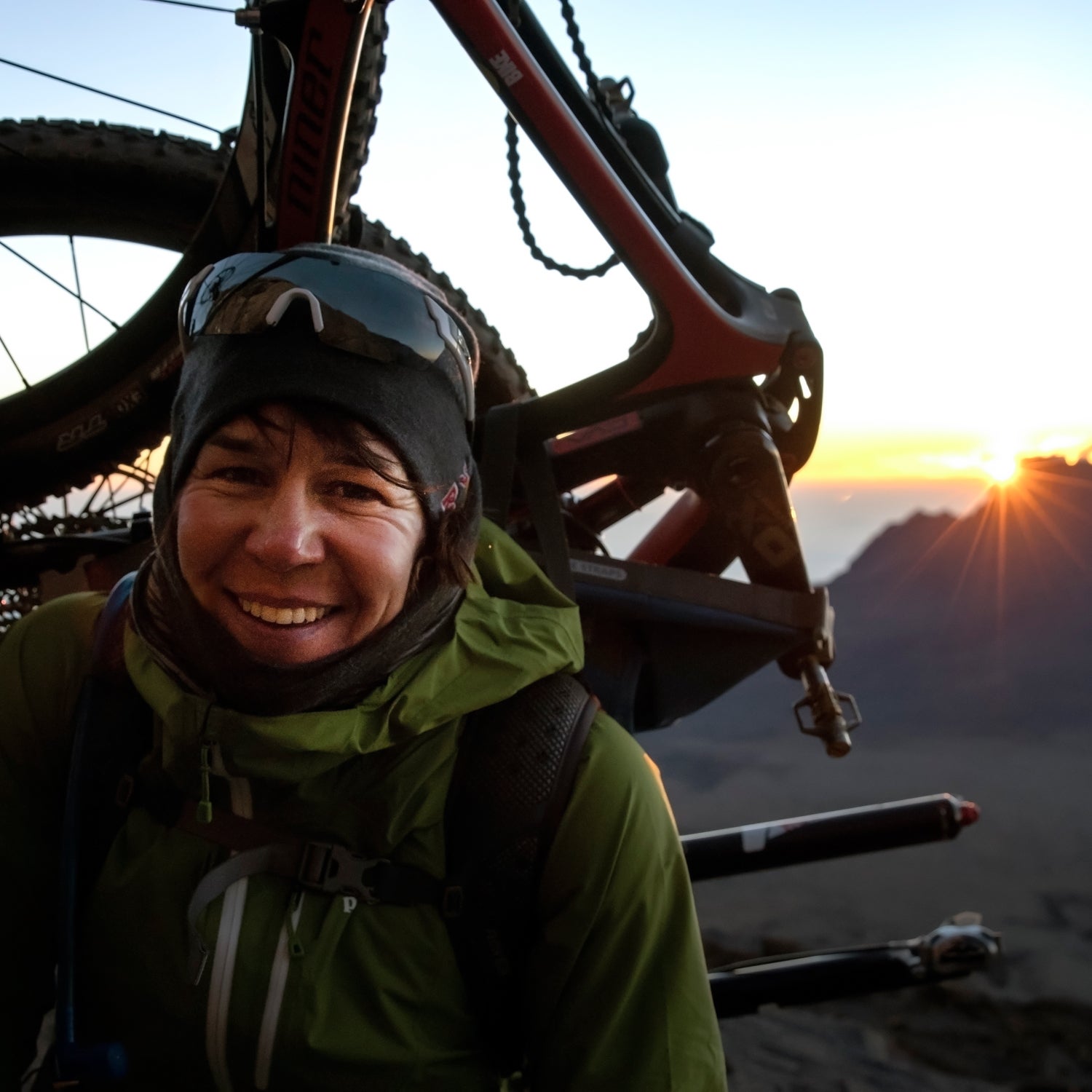It’s easy to see why is known as the Queen of Pain. For starters, the Red Bull athlete is an absolute monster on two wheels: she is a seven-time mountain bike world champion and has won the storied race a record-tying four times. She’s also won national and world championships in whitewater rafting, adventure racing, cross-country skiing, and orienteering, a sport that involves pathfinding in unfamiliar and rugged terrain. And although she is in her late 40s, Rusch has no intention of slowing down. This past March, Rusch and teammate became the third party ever to summit Mount Kilimanjaro via bikes.
I recently caught up with Rusch from her home in Ketchum, Idaho, to chat about her training, the ride up Kilimanjaro, and how she nurtures her body and mind for lasting peak performance.
Training
I train on my mountain bike as much as possible. The majority of my riding is long and relatively slow. I’d say only about 20 percent of my total training volume is high intensity.
I work with a coach who builds my workout schedule. Over time, I’ve realized the importance of being flexible and evolving the plan based on both how my body is adapting and the other things going on in my life. It’s hard to nail a big training week at the same time you are remodeling your house.
Favorite Workout
I love nothing more than a long 6 to 8 hour ride with friends on the mountain bike trails around Ketchum. I’m getting in the prescribed “long ride” workout and the great aerobic and strength benefits that come with it, but it’s easy to forget about that when I’m out in nature with friends.
Kilimanjaro Prep
In addition to my usual routine, I did some training that was more mountain-specific. While wearing a weighted vest and carrying a backpack, I walked up a steep incline on a treadmill in an altitude tent. I also slept in an altitude tent in the weeks leading up to the ride. Both strategies were immensely helpful—my body was well-adapted before I even stepped foot on the mountain.
Dealing with Dark Spots
Whenever I get down and catch myself with negative thoughts, I pretend I’m saying those things aloud to another person. I ask myself, would you ever say, “Well, it looks like you’re really blowing up, you’re day is over,” to a training partner who is struggling? Of course not! You’d tell him, “Keep pushing and just make it through the next five minutes.” Or maybe you’d say, “Eat, drink, and hang in there until the next aid station.” Going through this exercise helps me replace negative thoughts with positive ones.
I guess what I’m saying is that you’ve got to be kind to yourself. If you are kind to yourself, most of the time you’ll get through the dark spot in a better mood and without wasting precious energy ruminating.
Mind Over Matter
Meditation has become a key part of my routine. I use an app called and meditate for 10 minutes every day. This small part of my day carries over into everything else I do. It helps me stay more present and focused in the moment, which is integral to solid performance in just about any endeavor, including bike racing.
Daily Nutrition
My guiding credo is that I try not to eat anything that comes in a package. I eat a well-balanced diet of whole, natural foods. I’ve tried going gluten-free and vegetarian, but neither stuck. For me, staying away from processed foods is most important.
Performance Fueling
During longer endurance races, I aim for between 150 to 200 calories per hour, almost all of which are from sports drinks. It’s hard to take your hands off the [mountain bike] handlebars for too long, and eating can feel like a chore, so drinking a bottle, which I can easily and quickly consume with one hand, every hour works best for me.
The specifics of fueling—e.g., solid vs. liquid, what brand of energy gel to use —is individual. But once you have developed a plan that works for you, I can’t stress enough the importance of sticking to it. If you fall behind on nutrition and hydration, you start to feel crappy, which makes you want to eat and drink even less, which only makes you feel crappier. It’s a vicious cycle and a hole this is almost impossible to climb out of.
Recovery
I like to wear compression clothing after hard training and races and I also regularly use a foam roller. I’m not obsessive about it, but whenever I turn on the TV, I’ll hop on the [foam] roller at the same time.
Tactics like compression and foam rolling help at the margin, but by far the most important thing for my recovery is sleep. I sleep a ton—8 to 10 hours a night.
Aging Gracefully
You don’t need to be 25 years old to have your greatest performance. At age 47, I’m still improving and having some of the best days of my career. I may not be as strong or have the same VO2 max as when I was younger, but wisdom is the great equalizer. I’m smarter about things like nutrition and race tactics, and I have a special self-knowledge that only results from years of experience.
�Ѵdzپ������پ��Dz���
I tend to thrive most whenever I link what I’m doing to a greater purpose. For the Kilimanjaro ride, I worked with World Bicycle Relief, a charity that provides bikes to students and workers in rural Africa, to raise a dollar for every foot of elevation climbed. Those $19,341 dollars will purchase something like 120 bikes.
[Note: Rusch is just shy of her fundraising goal. You can learn more about World Bicycle Relief and donate .]


